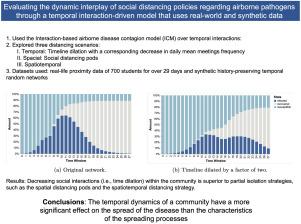当前位置:
X-MOL 学术
›
J. Biomed. Inform.
›
论文详情
Our official English website, www.x-mol.net, welcomes your feedback! (Note: you will need to create a separate account there.)
Evaluating the dynamic interplay of social distancing policies regarding airborne pathogens through a temporal interaction-driven model that uses real-world and synthetic data
Journal of Biomedical informatics ( IF 4.5 ) Pub Date : 2024-02-01 , DOI: 10.1016/j.jbi.2024.104601 Osnat Mokryn , Alex Abbey , Yanir Marmor , Yuval Shahar
Journal of Biomedical informatics ( IF 4.5 ) Pub Date : 2024-02-01 , DOI: 10.1016/j.jbi.2024.104601 Osnat Mokryn , Alex Abbey , Yanir Marmor , Yuval Shahar

|
The recent SARS-CoV-2 pandemic has exhibited diverse patterns of spread across countries and communities, emphasizing the need to consider the underlying population dynamics in modeling its progression and the importance of evaluating the effectiveness of non-pharmaceutical intervention strategies in combating viral transmission within human communities. Such an understanding requires accurate modeling of the interplay between the community dynamics and the disease propagation dynamics within the community. We build on an interaction-driven model of an airborne disease over contact networks that we have defined. Using the model, we evaluate the effectiveness of temporal, spatial, and spatiotemporal social distancing policies. Temporal social distancing involves a pure dilation of the timeline while preserving individual activity potential and thus prolonging the period of interaction; spatial distancing corresponds to social distancing pods; and spatiotemporal distancing pertains to the situation in which fixed subgroups of the overall group meet at alternate times. Our results demonstrate the superiority of decreasing social interactions (i.e., time dilation) within the community over partial isolation strategies, such as the spatial distancing pods and the spatiotemporal distancing strategy. In addition, we found that slow-spreading pathogens (i.e., pathogens that require a longer exposure to infect) spread roughly at the same rate as fast-spreading ones in highly active communities. This result is surprising since the pathogens may follow different paths. However, we demonstrate that the dilation of the timeline considerably slows the spread of the slower pathogens. Our results demonstrate that the temporal dynamics of a community have a more significant effect on the spread of the disease than the characteristics of the spreading processes.
中文翻译:

通过使用真实世界和合成数据的时间交互驱动模型,评估有关空气传播病原体的社会疏远政策的动态相互作用
最近的 SARS-CoV-2 大流行在国家和社区之间呈现出不同的传播模式,强调在对其进展进行建模时需要考虑潜在的人口动态,以及评估非药物干预策略在抗击病毒传播方面的有效性的重要性人类社区。这种理解需要对群落动态与群落内疾病传播动态之间的相互作用进行准确建模。我们建立在我们定义的接触网络上的空气传播疾病的交互驱动模型的基础上。使用该模型,我们评估了时间、空间和时空社会疏远政策的有效性。时间上的社交距离涉及时间线的纯粹扩张,同时保留个人活动潜力,从而延长互动时间;空间距离对应于社交距离舱;时空距离涉及整个群体的固定小组在交替时间见面的情况。我们的结果证明了减少社区内的社交互动(即时间膨胀)相对于部分隔离策略(例如空间距离隔离舱和时空距离策略)的优越性。此外,我们发现,在高度活跃的群落中,缓慢传播的病原体(即需要更长时间接触才能感染的病原体)的传播速度与快速传播的病原体大致相同。这个结果令人惊讶,因为病原体可能遵循不同的路径。然而,我们证明时间线的延长大大减缓了较慢病原体的传播。我们的结果表明,群落的时间动态对疾病传播的影响比传播过程的特征更显着。
更新日期:2024-02-01
中文翻译:

通过使用真实世界和合成数据的时间交互驱动模型,评估有关空气传播病原体的社会疏远政策的动态相互作用
最近的 SARS-CoV-2 大流行在国家和社区之间呈现出不同的传播模式,强调在对其进展进行建模时需要考虑潜在的人口动态,以及评估非药物干预策略在抗击病毒传播方面的有效性的重要性人类社区。这种理解需要对群落动态与群落内疾病传播动态之间的相互作用进行准确建模。我们建立在我们定义的接触网络上的空气传播疾病的交互驱动模型的基础上。使用该模型,我们评估了时间、空间和时空社会疏远政策的有效性。时间上的社交距离涉及时间线的纯粹扩张,同时保留个人活动潜力,从而延长互动时间;空间距离对应于社交距离舱;时空距离涉及整个群体的固定小组在交替时间见面的情况。我们的结果证明了减少社区内的社交互动(即时间膨胀)相对于部分隔离策略(例如空间距离隔离舱和时空距离策略)的优越性。此外,我们发现,在高度活跃的群落中,缓慢传播的病原体(即需要更长时间接触才能感染的病原体)的传播速度与快速传播的病原体大致相同。这个结果令人惊讶,因为病原体可能遵循不同的路径。然而,我们证明时间线的延长大大减缓了较慢病原体的传播。我们的结果表明,群落的时间动态对疾病传播的影响比传播过程的特征更显着。



























 京公网安备 11010802027423号
京公网安备 11010802027423号